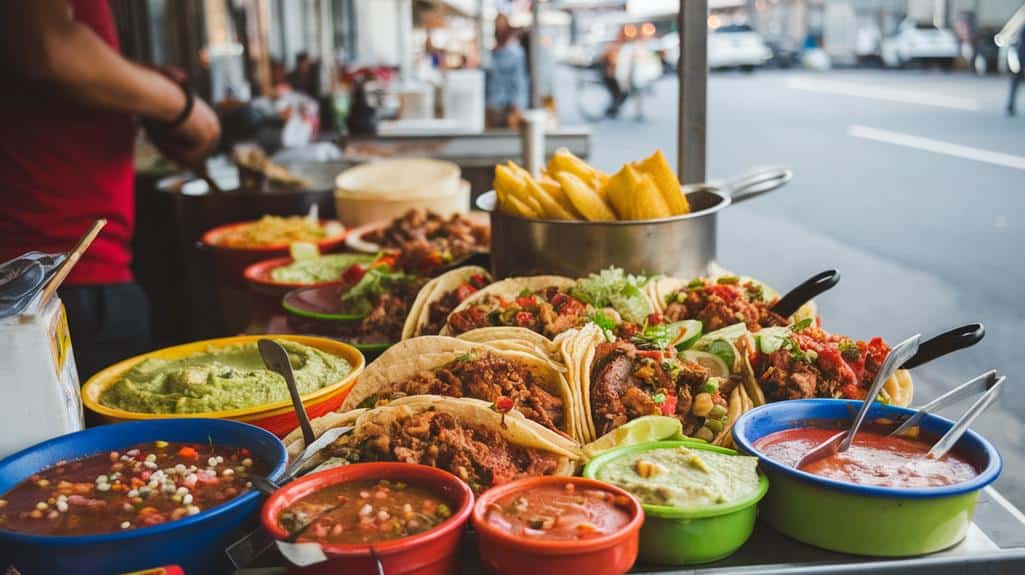
10 Mouthwatering Ways to Savor Mexico’s Local Flavors
Mexico's culinary landscape offers a mouthwatering array of local flavors to savor. You can embark on commence street taco tours, exploring hidden gems and popular taquerias. In Oaxaca, indulge in mole tastings, sampling the seven main varieties of this complex sauce. Baja California's coastline beckons with fresh seafood feasts, from Ensenada's fish tacos to Puerto Nuevo's lobster dinners. Mezcal and tequila tastings provide insights into Mexico's spirit-making traditions, while Merida's Yucatecan cuisine showcases unique dishes like cochinita pibil. Participate in cooking classes, chocolate experiences, and savor traditional pozole and tamales. For a farm-to-table experience, venture into rural Mexico to taste the country's diverse culinary heritage. Discover even more ways to immerse yourself in Mexico's rich gastronomic tapestry.
In a Nutshell
- Embark on street taco tours to taste authentic local cuisine and explore hidden gems.
- Experience mole tastings in Oaxaca to savor complex flavors and traditional recipes.
- Indulge in seafood feasts along Baja California's coast, featuring fresh catches and regional specialties.
- Participate in mezcal and tequila tastings to understand Mexico's spirit-making traditions.
- Discover Yucatecan cuisine in Merida, sampling dishes like cochinita pibil and sopa de lima.
Street Tacos and Taqueria Tours
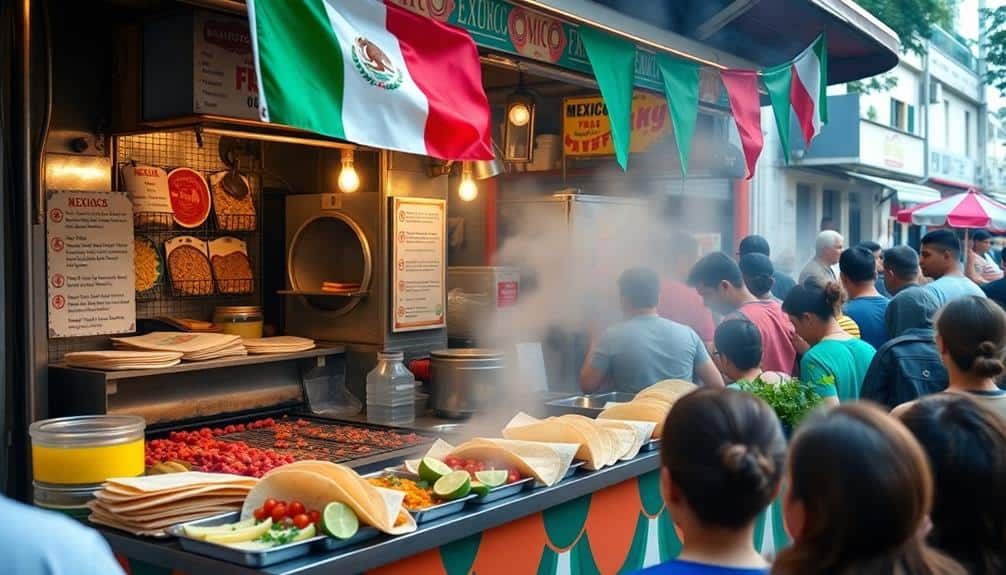
One can't truly experience Mexico without diving into its vibrant street food scene. Street tacos, a quintessential Mexican dish, offer an authentic taste of local cuisine. While exploring Mexico's culinary landscape, you might also consider packing a versatile travel backpack to carry your essentials and any food souvenirs you pick up along the way. You'll find taco stands, or "taquerias," on nearly every corner, serving up a variety of fillings from traditional carne asada to more adventurous options like lengua (beef tongue). To fully explore this culinary landscape, consider joining a taqueria tour. These guided experiences, often led by local food experts, will take you to hidden gems and popular spots alike. You'll learn about the history and preparation of different taco styles, regional variations, and proper eating etiquette. Many tours also include tastings of other street foods, such as elotes (grilled corn) and tamales. By participating in a taqueria tour, you'll gain a deeper understanding of Mexico's rich food culture.
Mole Tasting in Oaxaca
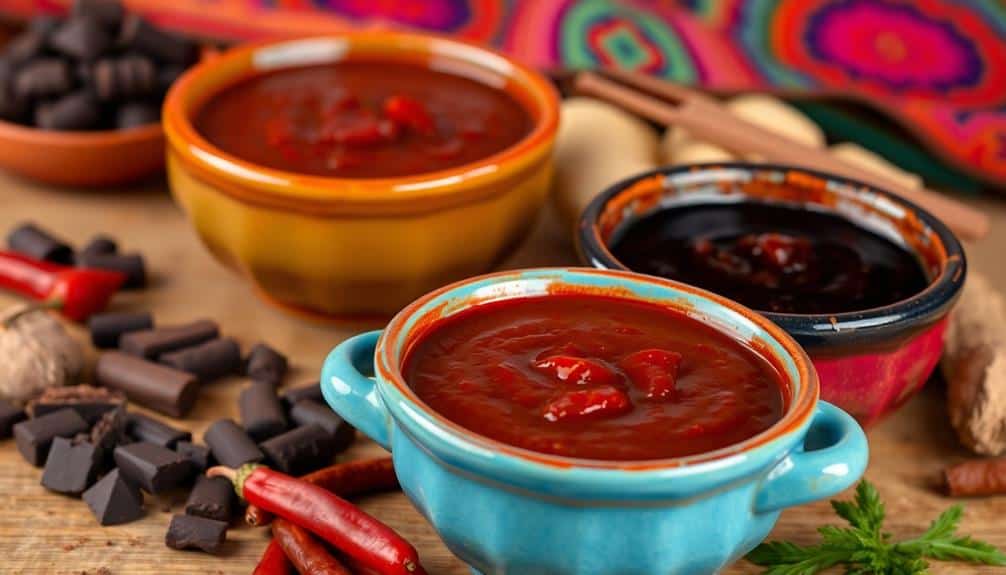
From street tacos to complex sauces, Mexico's culinary landscape is rich and diverse. In Oaxaca, you'll find one of the country's most intricate culinary traditions: mole. This complex sauce, often containing over 20 ingredients, comes in seven main varieties, each with its own distinct flavor profile. To truly appreciate Oaxacan mole, consider joining a guided tasting tour. These experiences typically include visits to local markets, where you'll learn about the ingredients, followed by a hands-on cooking demonstration. For those who enjoy documenting their culinary adventures, bringing along a travel journal can help capture the vibrant flavors and memorable experiences. You'll taste various moles, from the chocolate-tinged negro to the herb-infused verde, paired with traditional accompaniments like tamales or chicken. Many tours also offer the opportunity to visit family-run restaurants, where recipes have been passed down for generations. For the most authentic experience, look for tours led by local chefs or food historians.
Seafood Feasts in Baja California
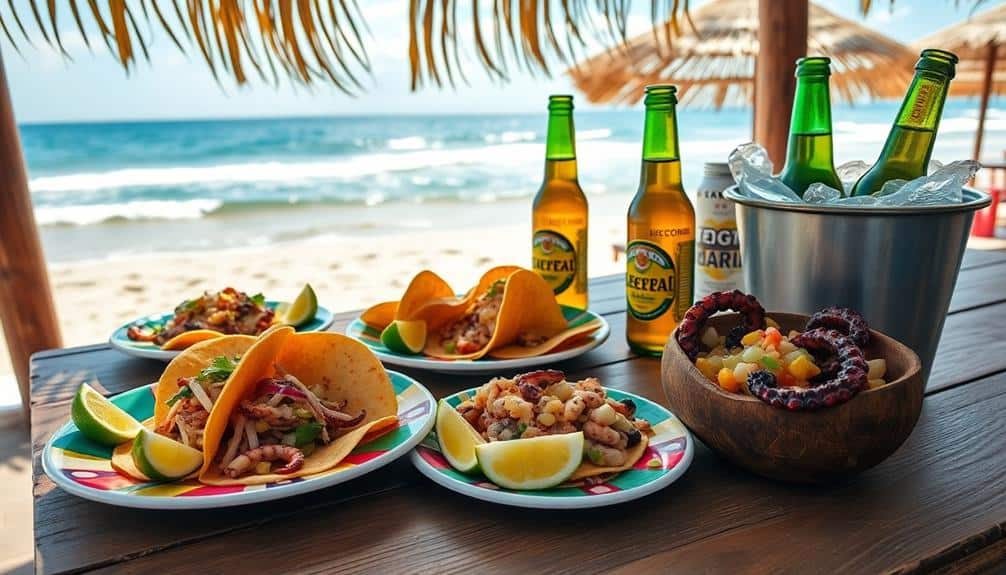
Baja California's coastline offers a seafood lover's paradise, with three distinct bodies of water surrounding the peninsula. You'll find an abundance of fresh catches, from Pacific lobster to Sea of Cortez shrimp. When exploring Baja's culinary scene, consider bringing a portable cooler to store and transport your favorite local delicacies. Ensenada, known for its fish tacos, is a must-visit destination for seafood enthusiasts. Here, you can indulge in crispy battered fish nestled in warm tortillas, topped with tangy slaw and creamy sauces.
To fully experience Baja's seafood scene:
- Visit Puerto Nuevo for its famous lobster dinners
- Try chocolate clams in La Paz, grilled with butter and garlic
- Sample sea urchin ceviche in Tijuana's Mercado Hidalgo
- Enjoy fish zarandeado in San Felipe, marinated and grilled over mesquite
Don't miss the opportunity to pair your seafood feast with local wines from Valle de Guadalupe, enhancing the flavors of Baja's coastal cuisine.
Mezcal and Tequila Tastings

Mexico's liquid treasures, mezcal and tequila, offer a journey into the heart of the country's spirit-making traditions. To fully appreciate these iconic beverages, you'll want to participate in guided tastings at renowned distilleries. In Jalisco, the birthplace of tequila, you can explore the agave fields and witness the meticulous production process. You'll learn to distinguish between blanco, reposado, and añejo varieties, noting the subtle flavor profiles imparted by aging in oak barrels. Mezcal tastings, often held in Oaxaca, introduce you to the smoky, complex flavors derived from various agave species. Expert mezcaliers will guide you through the nuances of each artisanal batch, explaining the traditional production methods that have been passed down through generations. Remember to sip slowly, savoring the distinct characteristics of each spirit.
Yucatecan Cuisine in Merida
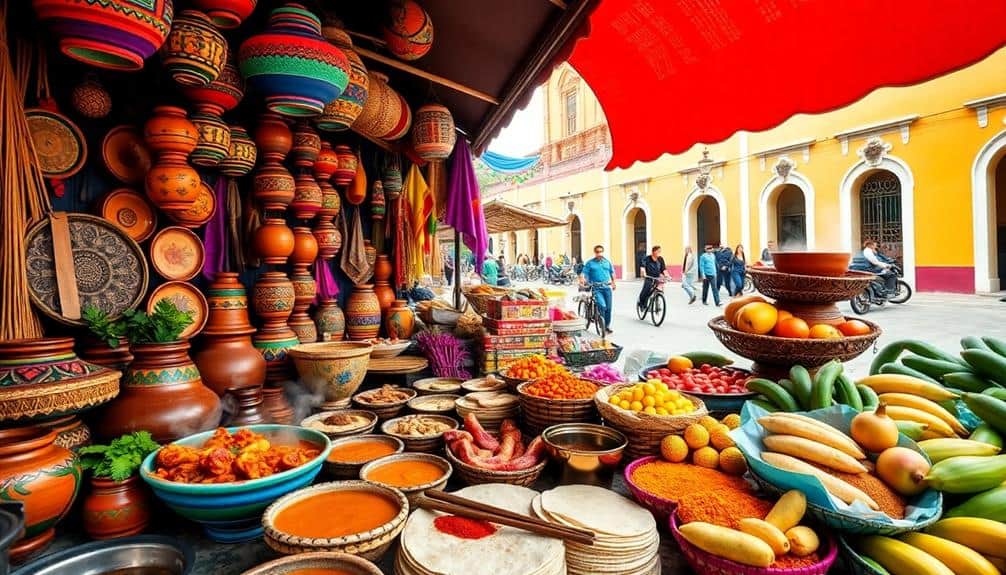
While spirits showcase Mexico's liquid heritage, the Yucatán Peninsula offers a feast for the senses through its distinctive cuisine. In Mérida, the capital of Yucatán state, you'll encounter a unique culinary tradition shaped by Maya, Spanish, and Caribbean influences. Yucatecan cuisine is known for its bold flavors, incorporating local ingredients like achiote, sour oranges, and habanero peppers.
To fully experience Mérida's gastronomic delights, consider trying these regional specialties:
- Cochinita pibil: Slow-roasted pork marinated in achiote and citrus juices
- Sopa de lima: Tangy lime soup with shredded turkey and crispy tortilla strips
- Papadzules: Corn tortillas filled with hard-boiled eggs and topped with pumpkin seed sauce
- Queso relleno: Hollowed-out Edam cheese stuffed with ground pork and spices
These dishes exemplify the region's culinary prowess, offering a true taste of Yucatecan tradition.
Mexico City's Vibrant Food Markets
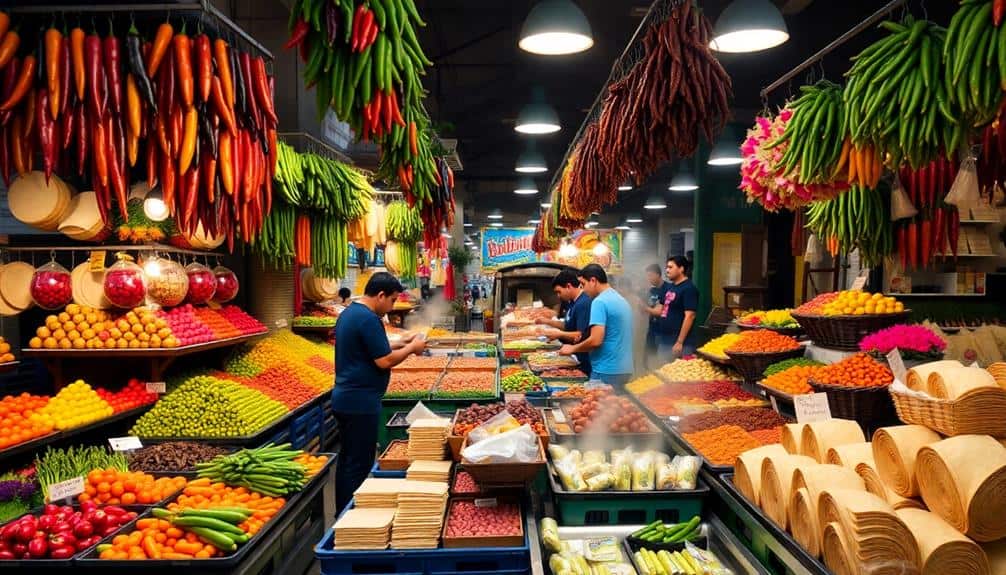
A culinary adventure awaits in Mexico City's bustling food markets. You'll find an array of local specialties, from fresh produce to artisanal cheeses and traditional sweets. The Mercado de San Juan, known as the "gourmet market," offers exotic ingredients and high-quality meats. Here, you can sample rare fruits, edible insects, and even wild game.
For a more traditional experience, visit the Mercado de la Merced, one of the city's largest markets. It's divided into sections, each specializing in different products. You'll discover countless varieties of chiles, moles, and spices. Don't miss the prepared food stalls, where you can taste authentic dishes like tlacoyos and quesadillas. The Mercado de Coyoacán, located in a charming neighborhood, is perfect for trying regional snacks and purchasing artisanal crafts.
Cooking Classes With Local Chefs
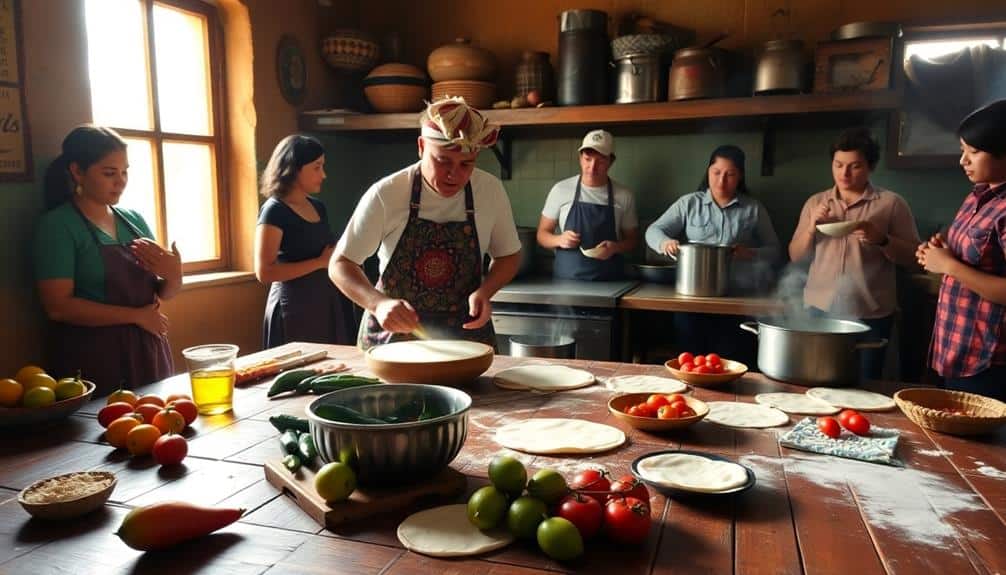
To truly immerse yourself in Mexico's culinary scene, you can't miss the opportunity to learn from local chefs. These hands-on experiences offer invaluable insights into traditional techniques, regional ingredients, and cultural nuances that shape Mexican cuisine. You'll find a variety of cooking classes available, ranging from intimate home-based sessions to professional kitchen workshops, each providing a unique perspective on local flavors.
When selecting a cooking class, consider these key factors:
- Chef's expertise and background
- Class size and duration
- Menu variety and regional focus
- Inclusion of market visits or ingredient sourcing
Most classes begin with an introduction to essential ingredients and tools, followed by step-by-step guidance through recipe preparation. You'll learn proper knife skills, seasoning techniques, and cooking methods specific to Mexican dishes. By the end of your session, you'll have gained practical skills and a deeper appreciation for Mexico's rich culinary heritage.
Chocolate and Cacao Experiences

Mexico's rich chocolate heritage spans thousands of years, offering visitors a plethora of cacao-based experiences. You'll find artisanal chocolate shops in major cities, where you can sample single-origin bars and learn about bean-to-bar processes. For a more immersive experience, visit cacao plantations in Tabasco or Chiapas, where you'll witness traditional harvesting methods and participate in chocolate-making workshops. In Oaxaca, don't miss the opportunity to taste authentic Mexican hot chocolate, prepared with a molinillo (wooden whisk) and served in clay mugs. Many museums across the country, such as the MUCHO Museo del Chocolate in Mexico City, offer interactive exhibits on chocolate's history and cultural significance. For a unique twist, seek out cacao-based spa treatments, which utilize the antioxidant properties of raw cacao in rejuvenating body wraps and facials.
Traditional Pozole and Tamales
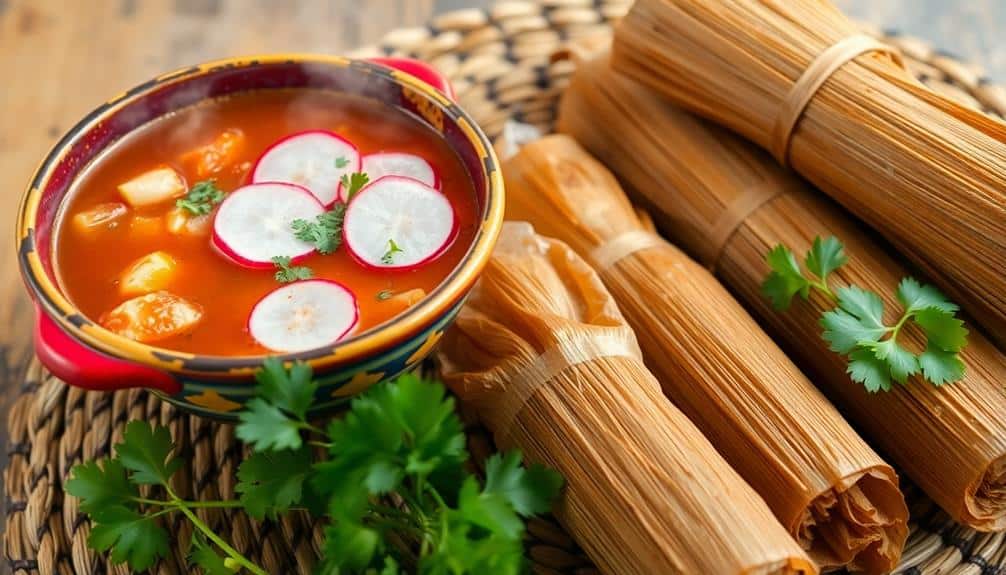
While chocolate holds a special place in Mexican cuisine, two other traditional dishes stand out as culinary icons: pozole and tamales. These hearty, flavorful creations offer a taste of Mexico's rich culinary heritage. Pozole, a hominy-based stew, comes in red, white, or green varieties, each bursting with tender meat and aromatic spices. Tamales, steamed corn dough parcels filled with savory or sweet ingredients, showcase regional variations across the country.
To fully appreciate these dishes:
- Seek out authentic, family-run restaurants or street vendors for the most genuine flavors
- Try different regional variations to experience diverse ingredient combinations
- Pair pozole with traditional garnishes like radishes, lettuce, and lime
- Learn the proper technique for unwrapping tamales to preserve their delicate texture
You'll find these dishes not only satisfying but also deeply connected to Mexico's cultural identity.
Farm-to-Table Dining in Rural Mexico
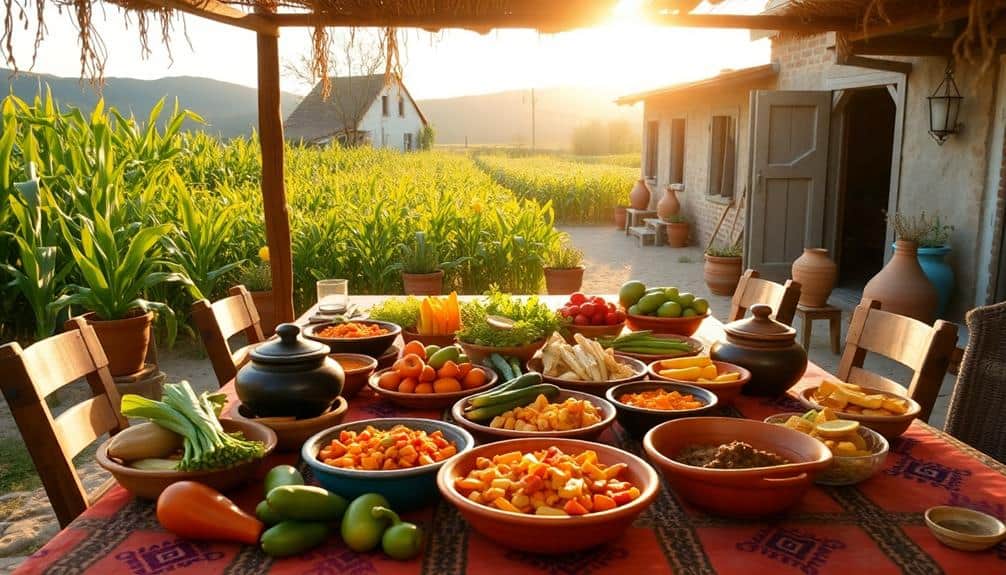
Have you ever wondered where some of Mexico's most authentic culinary experiences can be found? Search no further than the farm-to-table dining scene in rural Mexico. Here, you'll discover a world of fresh, locally-sourced ingredients transformed into traditional dishes bursting with flavor. Many small farms and ranches across the country have opened their doors to visitors, offering immersive dining experiences that showcase regional specialties.
You'll find yourself savoring dishes prepared with produce harvested mere hours before, meats from animals raised on-site, and herbs plucked from nearby gardens. These rural establishments often feature open-air kitchens where you can watch skilled cooks prepare your meal using time-honored techniques. From Oaxaca's mole-making demonstrations to Yucatán's pit-roasted cochinita pibil, farm-to-table dining in rural Mexico offers an unparalleled opportunity to taste the country's diverse culinary heritage in its purest form.
Frequently Asked Questions
What Are Some Essential Food Safety Tips for Eating in Mexico?
When eating in Mexico, you'll want to prioritize food safety. Stick to bottled water and avoid ice in drinks. Choose busy restaurants where food turnover is high. Opt for fully cooked, hot foods rather than raw or undercooked items. Be cautious with street food, ensuring vendors maintain proper hygiene. Wash your hands frequently or use hand sanitizer. Peel fruits and vegetables yourself when possible. If you're unsure about an establishment's cleanliness, it's best to find an alternative.
Are There Options for Vegetarians and Vegans in Traditional Mexican Cuisine?
Where there's a will, there's a way, and that's true for vegetarians and vegans in Mexico. You'll find plenty of options in traditional Mexican cuisine. Staples like beans, rice, and corn tortillas are naturally plant-based. Nopales (cactus paddles), chayote squash, and avocados feature prominently in many dishes. You can enjoy vegetarian versions of classics like enchiladas, tacos, and quesadillas filled with vegetables or plant-based proteins. Just be sure to clarify that you don't want lard or animal-based broths in your meals.
How Can I Navigate Food Allergies While Exploring Mexican Dishes?
To navigate food allergies while exploring Mexican dishes, you'll need to communicate clearly with restaurant staff about your specific restrictions. You should learn key Spanish phrases related to your allergies and common ingredients. It's wise to research traditional dishes beforehand, identifying potential allergens. Many Mexican staples can be modified to accommodate allergies, but always double-check. Consider carrying translation cards detailing your allergies, and when in doubt, opt for simpler dishes where ingredients are easily identifiable.
What's the Etiquette for Tipping at Restaurants and Street Food Stalls?
Like a seasoned traveler maneuvering uncharted waters, you'll want to approach tipping in Mexico with cultural sensitivity. At restaurants, it's customary to leave 10-15% of the total bill. However, you'll find that many establishments include a service charge, so check your bill carefully. For street food vendors, tipping isn't expected, but it's appreciated if you're particularly satisfied. In upscale restaurants, you might consider tipping 15-20%. Always have small bills handy for tipping convenience.
Are There Any Regional Mexican Dishes That Are Particularly Spicy?
You'll find several regional Mexican dishes that pack a fiery punch. Cochinita pibil from Yucatán, while not inherently spicy, is often served with habanero salsa. Aguachile from Sinaloa features raw shrimp in a spicy lime juice. Chipotle-based dishes from central Mexico can be quite hot. In Oaxaca, you'll encounter mole coloradito, which incorporates chilhuacle chiles. Don't forget about the intensely spicy salsa de chile de árbol, popular throughout Mexico, particularly in Jalisco.
